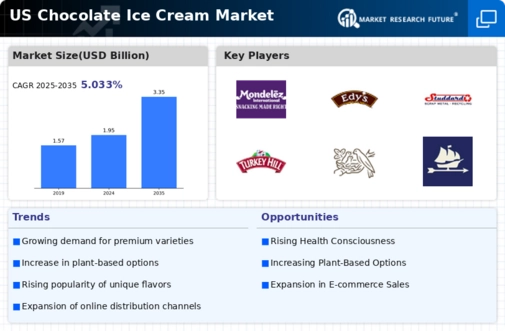Innovative Flavor Combinations
Innovation in flavor profiles is a significant driver in the chocolate ice-cream market, as brands experiment with unique combinations to attract adventurous consumers. The introduction of flavors such as chocolate chili, salted caramel chocolate, and chocolate with exotic spices has gained traction, appealing to a broader audience. Market data suggests that innovative flavors can increase sales by up to 20%, as they entice consumers to try new products. This trend encourages manufacturers to continuously explore creative avenues, thereby enhancing the overall chocolate ice-cream market. By offering distinctive flavors, brands not only capture consumer interest but also foster brand loyalty, as customers are more likely to return for unique taste experiences.
Rising Demand for Premium Products
The market is experiencing a notable shift towards premium offerings, driven by consumers' increasing willingness to pay for high-quality ingredients and unique flavors. This trend is reflected in the growth of artisanal brands that emphasize natural ingredients and innovative recipes. According to recent data, the premium segment of the ice-cream market has expanded by approximately 15% annually, indicating a strong consumer preference for gourmet options. As a result, manufacturers are investing in sourcing high-quality cocoa and dairy, which enhances the overall product appeal. This focus on premiumization not only elevates the chocolate ice-cream market but also allows brands to differentiate themselves in a competitive landscape, catering to discerning consumers who seek indulgent experiences.
Growing E-commerce and Online Sales
The rise of e-commerce has transformed the chocolate ice-cream market, providing consumers with convenient access to a wide variety of products. Online platforms enable brands to reach a broader audience, facilitating direct-to-consumer sales that were previously challenging. Recent statistics reveal that online sales of ice-cream products have surged by over 25% in the past year, indicating a shift in consumer purchasing behavior. This trend is particularly beneficial for niche brands that may not have a strong presence in traditional retail outlets. As e-commerce continues to grow, manufacturers are increasingly investing in online marketing strategies and partnerships with delivery services, thereby enhancing their visibility in the chocolate ice-cream market and catering to the evolving preferences of consumers.
Sustainability and Ethical Sourcing
Sustainability has emerged as a crucial factor influencing the chocolate ice-cream market, with consumers increasingly prioritizing products that are ethically sourced and environmentally friendly. Brands that commit to sustainable practices, such as using fair-trade cocoa and eco-friendly packaging, are likely to resonate with the growing demographic of environmentally conscious consumers. Recent surveys indicate that approximately 60% of consumers are willing to pay a premium for sustainably sourced products. This shift towards sustainability not only enhances brand reputation but also drives sales in the chocolate ice-cream market, as consumers seek to align their purchasing decisions with their values. Consequently, manufacturers are adapting their sourcing strategies to meet this demand, ensuring a positive impact on both the market and the environment.
Seasonal and Limited-Edition Offerings
The chocolate ice-cream market is significantly influenced by the introduction of seasonal and limited-edition flavors, which create a sense of urgency among consumers. Brands often launch special flavors during holidays or events, such as pumpkin spice chocolate for fall or peppermint chocolate for winter, which can lead to spikes in sales. Data indicates that limited-edition products can increase sales by as much as 30% during promotional periods. This strategy not only drives immediate revenue but also keeps the brand relevant in a fast-paced market. By leveraging seasonal trends, manufacturers can effectively engage consumers and encourage repeat purchases, thereby enhancing the overall appeal of the chocolate ice-cream market.
























Leave a Comment